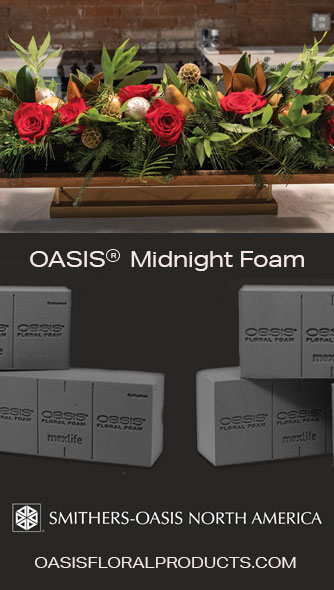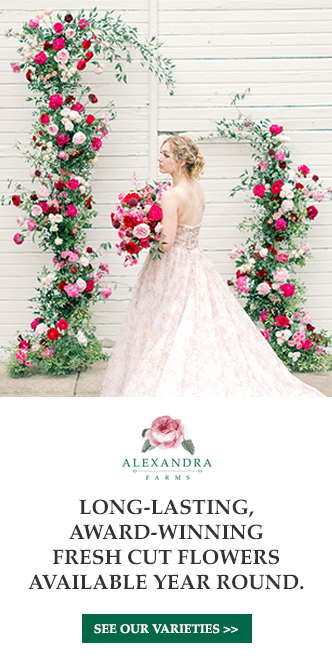Korean floral design beckons tranquility in a hectic world.
By Bianca Bina
Spacious, balanced and natural. Grounded in foundational principles, Korean design is built on a simple yet intentional framework that embraces ethereal, asymmetric forms. Every element is thoughtfully placed, with the goal of creating a dreamy, otherworldly aesthetic.
The use of organic properties that are placed to look as if untouched by human hands is as important as the open space provided for each stem to breathe in its base. Light pastels that are gently appealing to the eyes and paint an emotional collage of color play well with the airy vibe for a flowing installation. The asymmetry is key in these designs. It allows the artist to work intentionally with the organic shape of the botanicals and their natural rhythm. The delicacy of the composition is pivotal to the overall piece, as is the inclusion of their natural state.
Today, floral designers and educators are finding ways to combine their values, experiences and philosophies to create their own original fusions of traditional and modern designs. The teachings of Korean principles are in high demand by hobbyists and eager entrepreneurs around the world looking to expand their own education and new ways to intertwine tradition with modernity.
Lessons in Confidence
During the pandemic, many people sought creative outlets to keep busy and expand upon personal interests. Catyah Calantog-Aquino was one creative artist who used her talents and curiosity to build her future. Now a flower business owner, passionate designer and the Philippines’ first ever Korean-certified floral design teacher, her exceptional achievements were accomplished in just a few years of simply pursuing a soothing hobby to pass time.
“My first bouquet was a gift to my sister who was going through a difficult time emotionally,” she says. “Seeing how much joy that simple act brought her inspired me to keep creating and to spread happiness through flowers.”


Calantog-Aquino started Blooms Artisan in 2020 after attending numerous local workshops near her home in the Philippines, studying flowers and design. By 2023 she invested in her floral education in Korea. It’s the style of design that resonated with her most deeply, she says. Learning from Korean floral masters, she perfected techniques and principles that eventually led to her certification as a floral design instructor under the International Flower Design Association (IFDA) in Korea.
“What drew me to [Korean design] was its elegance and intentionality. There’s a quiet poetry in the way Korean designs bring harmony to line, color and form,” she explains. “The negative space, the use of minimal materials to create maximum emotional impact and the respect for nature—it all felt so meaningful and aligned with how I wanted to express floral art.”
Earning her certification was the catalyst for her next venture: Blooms Artisan Floral Academy (BAFA). This branch of her company brings aspiring Filipino designers together to learn Korean artistry to build careers or businesses of their own and become Korea-certified locally. While her classes are primarily aimed at budding entrepreneurs, many hobbyists drawn to the aesthetics of Korean design also enroll in search of creative fulfillment.
“Some are nervous at first—especially those who are new in floristry—but the calm and structured nature of Korean design often helps ease them in,” she notes. “We create a nurturing, fun and abundant learning environment where mistakes are welcome, and growth is celebrated.”
Just as she instills confidence in her students, Calantog-Aquino gained her own through trial and error—developing both her personal style and assurance, often unsure whether her approach reflected Korean design principles or simply her own preferences. “I found myself drawn to preserved flowers, particularly because they last for months to years with minimal care—something I saw as a metaphor for enduring love and beauty, and also more sustainable when starting a floral business.”

Today, Calantog-Aquino has expanded her preference of flowers while working her artistic muscle through her coursework and projects. While still including her symbolically soothing preserved flowers, she also works with traditional Korean florals, such as calla lily, Ranunculus, roses, sweet pea, Scabiosa and tulips, as well as ethereal pastel hues mixed with fillers like Astilbe, carnation and Cosmos. The combination creates a traditional yet modern juxtaposition of movement and texture.
In her classes, she continues to teach the traditional elements of Korean design, while also keeping up with the latest trends. Large-scale installations with cascading arches, suspended designs and immersive tablescapes that create a dreamlike setting currently are the preference for clients and designers looking to take on a challenge. Of course, sustainability also takes center stage with eyes set on seasonable botanicals, reusable structures and minimal waste.
“At Blooms Artisan and BAFA, we integrate these trends by teaching students to combine traditional Korean techniques with modern applications—whether it’s trying to use bold color in hand-tied bouquets, eco-conscious large installations or storytelling through personalized floral designs,” she says. “This fusion keeps our work both timeless and relevant.”
Calantog-Aquino’s team is also consistently adjusting and growing their catalog of workshops and courses to include trending practices and styles to keep up with the “evolving aesthetic of Korean floral design.” While she prefers to focus on the foundational techniques of Korean floristry, she remains open to incorporating contemporary trends that thoughtfully enhance the overall design.
“Ultimately, my goal is to create beauty that feels both intentional and deeply connected—arrangements that not only delight the eyes but also leave an emotional imprint on the heart.”
Natural Influence
Jung Da Yoon, a designer and educator based in Daegu, Korea, experienced a thorough education in Korea and Germany, earning a master’s degree in horticulture and later immersing herself in European flower culture in London, Paris and Belgium. In all, she’s spent nearly 23 years practicing horticulture and design, launching her brand Aulling Atelier and earning high regard throughout the industry for her original take on Korean European fusion design. Now, she travels the world and invites others to her studio in Korea to learn more about her aesthetic and practices. Her European and Korean mix of educational influence is particularly intriguing and sets her apart from her peers.


“I grew and developed my own design by merging Korean flower culture and European flower culture characteristics through learning Korean flower culture,” she says. “I wanted to build my own design world based on the experience I learned in many countries.”
While Korean design focuses on space, fewer flowers and natural beauty, German design is structural and frame-based with an overabundance of flowers. The two practices are seemingly opposite in approach. But Jung saw the potential to combine them.
The overarching influence she uses to design her pieces is to approach them all as a metaphor for life. With her first pregnancy, she realized the preciousness of human life, the energy each human expels and the importance of her own values and philosophy. “Flowers are also living things, and they all start from small seeds, but each has its own energy and is born in its own form,” she describes. “Here, I’m very deeply inspired and enlightened. With this as an opportunity, I begin to express my flower world by utilizing various colors and textures in my flower design and various materials that exist on Earth.”
Following in traditional Korean design, Jung’s style is an ethereal fantasy, dreamlike and whimsical in her selection of colors and textures. Her inclusion of natural elements, such as vegetables, fruits and branches, also keeps with traditional practices but adds a modern touch. It is most important to her that her work appears organic and garden-like, as if untouched by human hands.

She notes that she’s been a lifelong student of Mother Nature, her heaviest influence. “I spent my childhood in a rural village in Korea. Nature has always been my greatest teacher and the source of my senses. Looking at nature, I learned a unique perspective on the rhythm of harmony.”
That harmony extends beyond the collaboration of hues and shapes, and the fusion of Korean and European practices, encompassing both modern and traditional influences in each design. Jung believes in the potential of combining new trends with standard principles to continue evolving with the industry. She sees this as an opportunity to also evolve herself, injecting “new life and senses” into her designs.
“I want to [create] art that communicates with the world, not my own isolated art,” explains Jung. “I want to pursue that path and further develop my flower design in a way that coexists with the world’s dynamism and rapidly changing trendiness and nature.”
Global Resonance
As the popularity of Korean design continues to take hold, the application of traditional principles becomes ever more important. The simplicity makes the style harmonious when combined with other design styles. The result: something new and unexpected.
“I believe Korean design resonates globally because it captures something universal: beauty in simplicity,” Calantog-Aquino says. “It evokes a sense of calm, elegance and intentionality that feels both modern and timeless.” This particular style encourages calm and slowness in a world where abundance isn’t always what’s necessary. “In an increasingly fast-paced world, Korean floral design offers a moment of stillness and softness—and that’s something people deeply crave, especially during life’s most meaningful celebrations.”





















